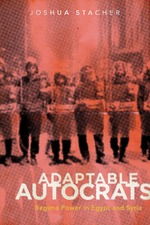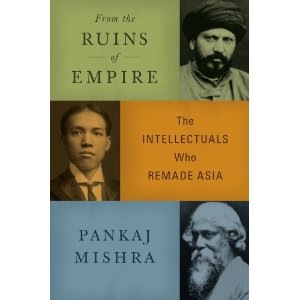 One-time contributor to the blog Joshua Stacher recently published his book, Adaptable Autocrats: Regime Power in Egypt and Syria. Since the 2011 uprisings, there has been a debate in Middle Eastern academia as to whether regional specialists focused too much on the persistence of authoritarianism (and power elites in particular) and not enough on the societies (and social movements in particular.) Of course, the two are not mutually exclusive, and the debate has had its ups and down according to what’s in the news. In this book, Josh looks the regime structures as an indication of both regime sustainability and adaptability, and applies this research to how Egypt and Syria handled the uprisings and their aftermath.
One-time contributor to the blog Joshua Stacher recently published his book, Adaptable Autocrats: Regime Power in Egypt and Syria. Since the 2011 uprisings, there has been a debate in Middle Eastern academia as to whether regional specialists focused too much on the persistence of authoritarianism (and power elites in particular) and not enough on the societies (and social movements in particular.) Of course, the two are not mutually exclusive, and the debate has had its ups and down according to what’s in the news. In this book, Josh looks the regime structures as an indication of both regime sustainability and adaptability, and applies this research to how Egypt and Syria handled the uprisings and their aftermath.
Josh writes:
Rather than explain the transition, this book compares how the structure of executive power allows for an authoritarian regime to change its ruling coalition (or not). Thus, it explains why Egypt could rapidly begin a transition while Syria could not. In the case of Egypt, this meant a long-time dictator and the neoliberal team could be removed and replaced by SCAF while “the state” remained in tact. Contrastingly, no such coalitional alterations could be made in Syria and is why its state was drawn into a long conflict with society as a consequence of the challenges posed by popular mobilization. The book does this by comparing institution building during the 1970s as well as examines elite and non-elite politics during the last decade in Egypt and Syria.
We are reprinting below the abstract of the book and an excerpt from its introduction to give readers a sense of the argument.
From the abstract:
The decades-long resilience of Middle Eastern regimes meant that few anticipated the 2011 Arab uprisings. But from the seemingly rapid leadership turnover in Egypt to the protracted stalemates in Yemen and Syria, there remains a common outcome: ongoing control of the ruling regimes. While some analysts and media outlets rush to look for democratic breakthroughs, autocratic continuity—not wide-ranging political change—remains the hallmark of the region’s upheaval.
Contrasting Egypt and Syria, Joshua Stacher examines how executive power is structured in each country and argues these preexisting power configurations shaped the uprisings and, in turn, the outcomes. Presidential power in Egypt was centralized. Even as Mubarak was forced to relinquish the presidency, military generals from the regime were charged with leading the transition. The course of the Syrian uprising reveals a key difference: the decentralized character of Syrian politics. Only time will tell if Asad will survive in office, but for now, the regime continues to unify around him. While debates about election timetables, new laws, and the constitution have come about in Egypt, bloody street confrontations continue to define Syrian politics—the differences in authoritarian rule could not be more stark.
Political structures, elite alliances, state institutions, and governing practices are seldom swept away entirely—even following successful revolutions—so it is vital to examine the various contexts for regime survival. Elections, protests, and political struggles will continue to define the region in the upcoming years. Examining the lead-up to the Egyptian and Syrian uprisings helps us unlock the complexity behind the protests and transitions. Without this understanding, we lack a roadmap to make sense of the Middle East’s most important political moment in decades.
And is an excerpt from the introduction of Adaptable Autocrats:
While there are similarities for why Syrians and Egyptians revolted against their political elites, there seems to be one key difference in why the outcomes varied. In Egypt, power was centralized prior to the uprising. When the protests occurred, the homogeneous character of society helped protesters overcome their previous collective action problems as they put aside their political differences. Their unified mobilizing pressure, combined with a rapid change in the balance of power between the coercive forces and the demonstrators, enabled a dynamic whereby members of the centralized ruling coalition could be and had to be dropped to save the regime. Then, when Mubarak became untenable at the helm, the SCAF could force his departure and slide into the centralized position of authority. While the SCAF was weak initially, it was in a better position to offset the continuous challenges from below.
Syria had no such luck. The heterogeneity of its society made centralized authority a difficult prospect in the early years of state formation. Hafiz al-Asad rectified this with his development of a cross-sectarian decentralized ruling coalition that shares power and works together to keep the state intact. It is an imperfect system, but it has not provided much governing turnover. After the uprising started in Syria, options for a coalition transition did not exist. This reduced the crisis to a question of the regime’s survival. The constituent parts of the regime would either hang together or collapse. In addition to forcing hands of the state elites to deploy repression, it revealed the decentralized and weak character of the state. When the population had to choose between a life in a weak state and no state and rising sectarianism in a diverse society, it chose the former.
…
To understand how Egypt and Syria emerged from the 2011 uprisings, researchers need to identify and explain how power was configured prior to them. By doing so, we must recognize and analyze the differences of systems that are often grouped together. Although researchers working on the Middle East regularly distinguish between monarchies and republics, scholars of comparative politics have not explored other differences within these categories in an explicit way. Examining the staple textbooks on Middle East politics proves this point. Yet, as the uprisings suggest, authority is structured and operates differently in these cases. This poses an important question: Which autocrats are most successful at adapting their political systems?
By exposing the differences in how autocrats adapt these systems, we gain new perspectives and understandings about regime power in the Middle East. Whether elites like it or not, political change is inescapable. Government officials have vested interests in apprehending and managing this process. As the Cairo bureau chief of the pan-Arab daily al-Hayat explains, “It is in a regime’s interest to change so that it can stay in power. They reform to keep the [political] system going.” Such “reforms” help rulers avoid more radical changes in the future.
This book argues that Arab elites are not initiating reform processes, but rather are engaging in adaptation. Autocratic adaptation helps regime elites maintain their dominant position and hierarchical authority over society. Adaptation can be defined as political change that adjusts a state to changes in its environment (such as a more mobilized, complex society, weakening state economic capabilities, external pressures, and so on) without giving up power or sacrificing the cohesion of elites. Adaptation takes place through controlled openings. Specifically, researchers can see adaptation when new groups are incorporated into the ruling coalition or when previously privileged members are dropped. Co-optation, or the inclusion of new figures and groups, shifts the state’s social base and allows ruling elites to pursue organizational innovations in state institutions. However, adaptation does not mean that incumbent elites seek intentionally to transform or restructure existing relationships between the rulers and the ruled. In examining adaptation, we journey behind the iron curtain to examine the microdynamics of co-optation in such political systems.
Excerpted from Adaptable Autocrats: Regime Power in Egypt and Syria by Joshua Stacher, by permission of the author. © 2012 by the Board of Trustees of the Leland Stanford Junior University. For more information, or to order the book, click here or visit the AUC bookstore. It is also available on Amazon.
Joshua Stacher is Assistant Professor of Political Science at Kent State University. He was recently selected to be a fellow at the Woodrow Wilson International Center for Scholars in Washington DC during the 2012–2013 academic year. He is a regular contributor to and on the editorial board of MERIP’s Middle East Report.He has made media appearances and written commentary for NPR, CNN, BBC, Al-Jazeera, Foreign Affairs, Jadaliyya, and The Boston Globe, among others. He is also a founding member of the Northeast Ohio Consortium on Middle East Studies. His personal website is here.
 BBC correspondent Jeremy Bowen is a fine journalist, and I enjoyed his book on the 1967 Arab-Israeli war. I just received his latest, on the Arab uprisings, and I have to ask: is this cover really appropriate? I mean, are the Arab uprisings best illustratd by Bowen's face?
BBC correspondent Jeremy Bowen is a fine journalist, and I enjoyed his book on the 1967 Arab-Israeli war. I just received his latest, on the Arab uprisings, and I have to ask: is this cover really appropriate? I mean, are the Arab uprisings best illustratd by Bowen's face? Our friend Yvez Gonzalez-Quijano, of the fantastic blog Cultures et Politiques Arabes, has a new book out on "the Spring of the Arab web," called Arabités Numeriques. It tracks the evolution of the Arab web, its early manifestations on various social services as a political force and its role in the uprisings and the post-uprising period — including the negative role the web plays, including the notion of "cyber-pessimism."
Our friend Yvez Gonzalez-Quijano, of the fantastic blog Cultures et Politiques Arabes, has a new book out on "the Spring of the Arab web," called Arabités Numeriques. It tracks the evolution of the Arab web, its early manifestations on various social services as a political force and its role in the uprisings and the post-uprising period — including the negative role the web plays, including the notion of "cyber-pessimism." Stephen Starr's Revolt in Syria is an account of the early phase of the Syrian insurrection by a journalist who lived there for several years, with insight into Syrian society.
Stephen Starr's Revolt in Syria is an account of the early phase of the Syrian insurrection by a journalist who lived there for several years, with insight into Syrian society. John Wright's A History of Libya is an updated edition of well-regarded standard, the first such book to be published since the uprising. I reviewed older books about Libya last year, and this one has the merit of going into pre-modern Libya (Vandals!) in great detail.
John Wright's A History of Libya is an updated edition of well-regarded standard, the first such book to be published since the uprising. I reviewed older books about Libya last year, and this one has the merit of going into pre-modern Libya (Vandals!) in great detail.

